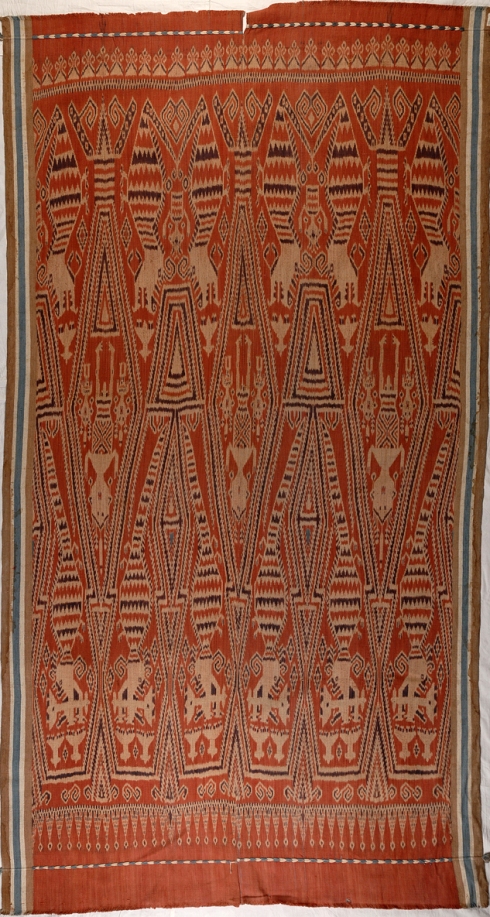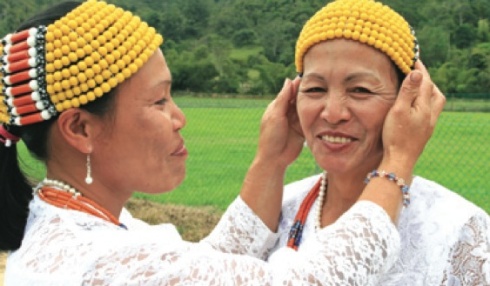The National Textile Museum Kuala Lumpur and Cultural impact Sdn Bhd are proud to introduce “Sacred Ikat: From Heirloom to Trade”. This exhibition is at the Textiles museum until October 23rd.
Ikat textiles are found in cultures all over the world. Ikat is being woven in Argentina, Bolivia, Ecuador, Guatemala and Mexico and also in Uzbekistan in Central Asia. India, Japan and several South-East Asian countries have long histories of Ikat production. Among the most admired ikat come from the island of Sumba and also from Sarawak. The Pua Kumbu – of Sarawak- shares many similarities with the Hinggi of Sumba, yet the legends, symbolism and rituals that surrounding the two vary.
 It’s a wonderful opportunity to see beautiful textiles from Sumba and Sarawak.
It’s a wonderful opportunity to see beautiful textiles from Sumba and Sarawak.
A series event is organized in conjunction with the exhibition, starting on Tuesday September 20th,with a Textile Forum with international textiles experts : Judy Knight Achjadi, Edric Ong and Marie-Christine Tseng. The panel of speakers will deliberate on the development of the weaving and lifestyles of the Sumbanese and Ibans. They will also examine the balance between aesthetics and practicality of these ikat textiles. ADMISSION is Free.
For the Forum, please register by replying to this email address: syahrul@jmm.gov.my; or asmah@jmm.gov.my
or call Syahrul or Nor Asmah @ 03-26943457/03-26943461
The National Textile Museum is housed in an elegant and historic building of Indo-Saracenic architecture. It is flanked by the Sultan Abdul Samad building and the DayaBumi complex at 26 Jalan Sultan Hishamuddin, near Merdeka square, Kuala Lumpur. Metro stations “Masjid Jamek” or “Pasar SeniP”. For more information, visit the Website: www.jmm.gov.my
Related posts : the Tun Jugah Foundation, Pua Kumbu Museum in Kuching ; The Society Atelier, organises the World Eco Fiber and TextilesForum (WEFT), Kuching ; Kuching page; Mats of Sarawak by Heidi Munan; Iban sleeping Mat by Heidi Munan, GERAI OA The Indigenous people stall where you can buy Pua Kumbu in KL, Museum Volunteers Malaysia.

Pua Kumbu, Sarawak

Sumba ikat



 The bead culture of Sarawak, part of a greater Malaysian heritage, is rooted in centuries of tradition. An ancient maritime trading network linked Sarawak to the world. The beads most treasured today came from production centres on the Malay Peninsula, from India, China and even further afield. In the hands of Sarawak‘s craftswomen and collectors, these masterpieces of the glassmaker‘s art became intrinsically “Borneo Beads”.
The bead culture of Sarawak, part of a greater Malaysian heritage, is rooted in centuries of tradition. An ancient maritime trading network linked Sarawak to the world. The beads most treasured today came from production centres on the Malay Peninsula, from India, China and even further afield. In the hands of Sarawak‘s craftswomen and collectors, these masterpieces of the glassmaker‘s art became intrinsically “Borneo Beads”.
 It’s a wonderful opportunity to see beautiful textiles from Sumba and Sarawak.
It’s a wonderful opportunity to see beautiful textiles from Sumba and Sarawak.

 What’s a flashpacker?
What’s a flashpacker? It was a place where you store the horse carriages.
It was a place where you store the horse carriages.